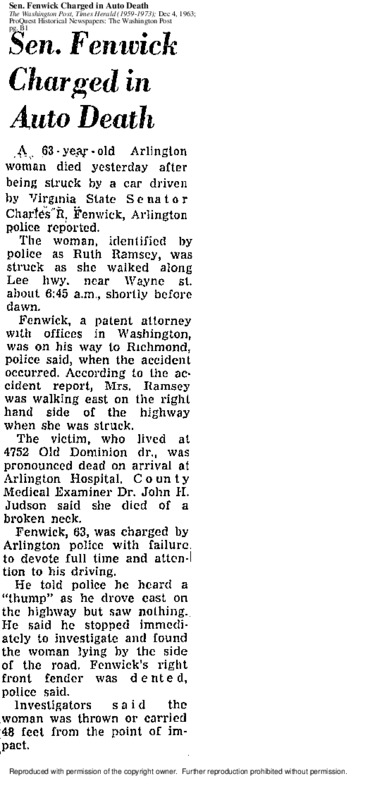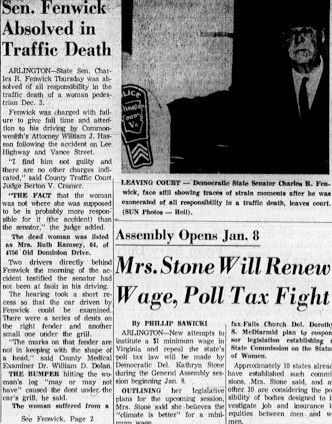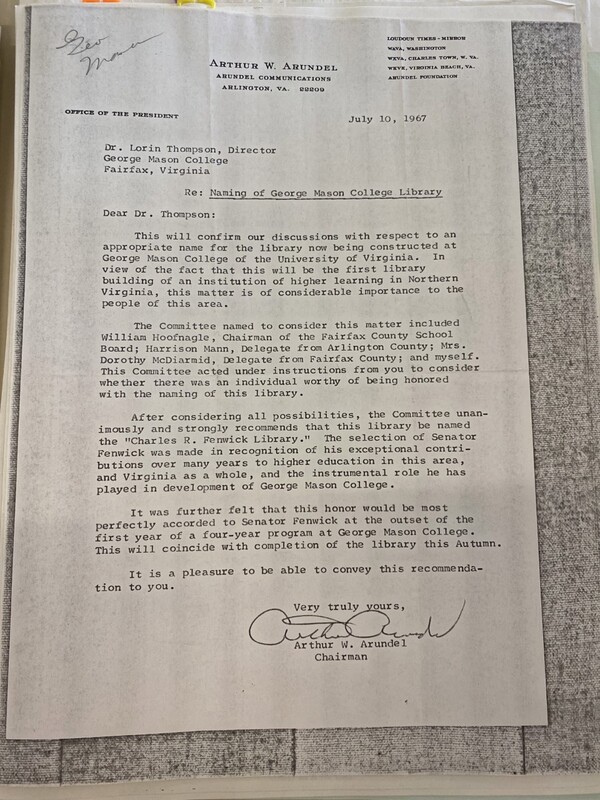Building an Institution for Northern Virginia During a Time of Personal Tragedy and Controversy
Later in 1963 a controversy swirled around Charles Fenwick that had little to do with desegregation. Early one December morning he was driving a few miles from home and hit a female pedestrian on the side of Lee Highway. The victim, Ruth Ramsey, was “thrown or carried 48 feet from the point of impact” and died of a broken neck sustained in the violent collision with Fenwick’s car fender. An investigation ensued; questions were asked about his mindset behind the wheel. A charge was filed against Fenwick with potential criminal liabilities by the Commonwealth's Attorney. Fenwick was absolved of all charges the following month by County Traffic Court Judge Berton V. Cramer who said that Ramsey was "probably more responsible" for the accident because she was walking in the road. Several witnesses corraborated Fenwick's account and his defense attorney was quoted in the Northern Virginia Sun that "[t]here was no evidence" that Fenwick was negligent and that "no one could suffer more than he has suffered."[1]
Fenwick recovered from the tragic accident and seemed to direct his attention to the expansion of GMC, which was about to benefit from a “bond issue” slated to raise several million dollars for infrastructural development. By the middle 1960s, the Advisory Committee was considering proposals for enlarging the college footprint with “academic building[s]” that attracted undergraduates wanting “a four-year curriculum.” One set of blueprints laid out a new facility with “31,640 square feet of space” that could accommodate conference rooms, “carrel-type seating,” and at least 50,000 volumes in accessible stacks. The exterior and interior design by William F. Vosbeck of Alexandria, Virginia, would be showcased in the “architectural exhibition at the National Convention of School Administrators . . . in Atlantic City, N.J.” Wayne Construction Co., “the general contractor,” started “this $1.2 million [library project] . . . in July, 1966.” The doors to a new lobby with book-charging desk and mezzanine were to open in the following year. The finished facility still anchors the university. It faces Horizon Hall. Wilkins Plaza and the Enslaved People of George Mason Memorial, and the Johnson Center, a hub of student activity, are a short stroll away. The red-brick library edifice has white columns. Thomas Jefferson’s residence, Monticello, and other facades at the University of Virginia in Charlottesville have white columns and red brick. These pillars and colors, and what they were supposed to imitate, were signal features of Vosbeck’s model to remake what was called in 1967 “a division of the School of General Studies of the University of Virginia, . . . [at] the George Mason campus.”[2]
As the library neared completion, Dr. Lorin Thompson, the GMC Director, sought to bestow a title on this building “now being constructed at George Mason College of the University of Virginia.” Thompson convened a committee with instructions to assign the “first library . . . of an institution of higher learning in Northern Virginia” with the name of an individual “worthy of being honored” by “the people of this area.” In the summer of 1967, the committee consisted of four members: “William Hoofnagle, Chairman of the Fairfax County School Board; Harrison Mann, Delegate from Arlington Country; Mrs. Dorothy McDiarmand, Delegate from Fairfax County; and” Arthur Arundel, a communications and media consultant based in Arlington. Arundel delivered the final decision to Dr. Thompson in two paragraphs of unstinting praise:
After considering all the possibilities, the Committee unanimously and strongly recommends that this library be named the ‘Charles R. Fenwick Library.’ The selection of Senator Fenwick was made in recognition of his exceptional contributions over many years to higher education in this area, and Virginia as a whole, and the instrumental role he has played in development [sic] of George Mason College.
It was further felt that this honor would be most perfectly accorded to senator Fenwick at the outset of the first year of a four-year program at George Mason College. This will coincide with completion of the library this Autumn.[3]
In December 1967 Dr. Edgar Shannon, President of the University of Virginia, declared that George Mason College’s new library would be “named for veteran state legislator Charles R. Fenwick of Arlington.” Shannon made the announcement at a dedication ceremony that recalled Fenwick “turn[ing] the first spadeful of dirt at ground-breaking ceremonies for the present campus just south of Fairfax City in 1963.” Virginia’s Lt. Governor Fred Pollard, “the principal speaker,” echoed adulation for Fenwick. “Mrs. Edmund D. Campbell, president of WETA-TV,” a public television channel, also presented her words of thanks. “It seems most appropriate,” she said, “that the library should be named for Sen. Fenwick.” Campbell was speaking in her capacity as “another [GMC] advisory committee member.” She added that Fenwick “was . . . a kind of bridge between the State, the university and the Northern Virginia area. Without his efforts we would not have a George Mason College here at this time.” At the end of his life, Fenwick battled cancer. Struggling with the dread disease doubtless made him much more aware of “time consuming procedure.” Months before passing away, Fenwick voiced misgivings that George Mason might soon try to be independent without the “prestige and superior” intellectual standing “that would justify it being separated from the parent institution.” Any impending split from the University of Virginia, he reasoned, “would be a great disservice to students” of GMC because they “would be deprived of quality education.”[4]
[1] Washington Post, Dec. 4, 1963; "Sen. Fenwick Absolved in Traffic Death," Northern Virginia Sun, 3 January 1964, 1-2.
[2] Fairfax City Times, Feb. 23, 1967; Falls Church Globe, June 1, 1967; Northern Virginia Sun, June 15, 1967; University Libraries, Special Collections, C. Harrison Mann Collection, Box 75, Folder 9.
[3] Letter, Arthur Arundel, Arlington, to Dr. Lorin Thompson, George Mason College, Fairfax, July 10, 1967, University Libraries, Special Collections, C. Harrison Mann Collection, Box 75, Folder 9.
[4] Northern Virginia Sun, Dec. 16, 1967; Letter Charles Fenwick, Arlington, to Northern Virginia Sun Editor, Arlington, June 12, 1967 (the letter concluded with “cc: Mr. Lorin Thompson, Chancellor, George Mason College”; University Libraries, Special Collections, C. Harrison Mann Collection, Box 75, Folder 2.
Kyle Filter


